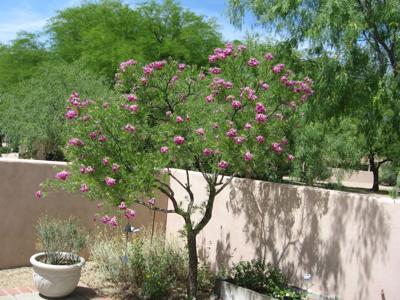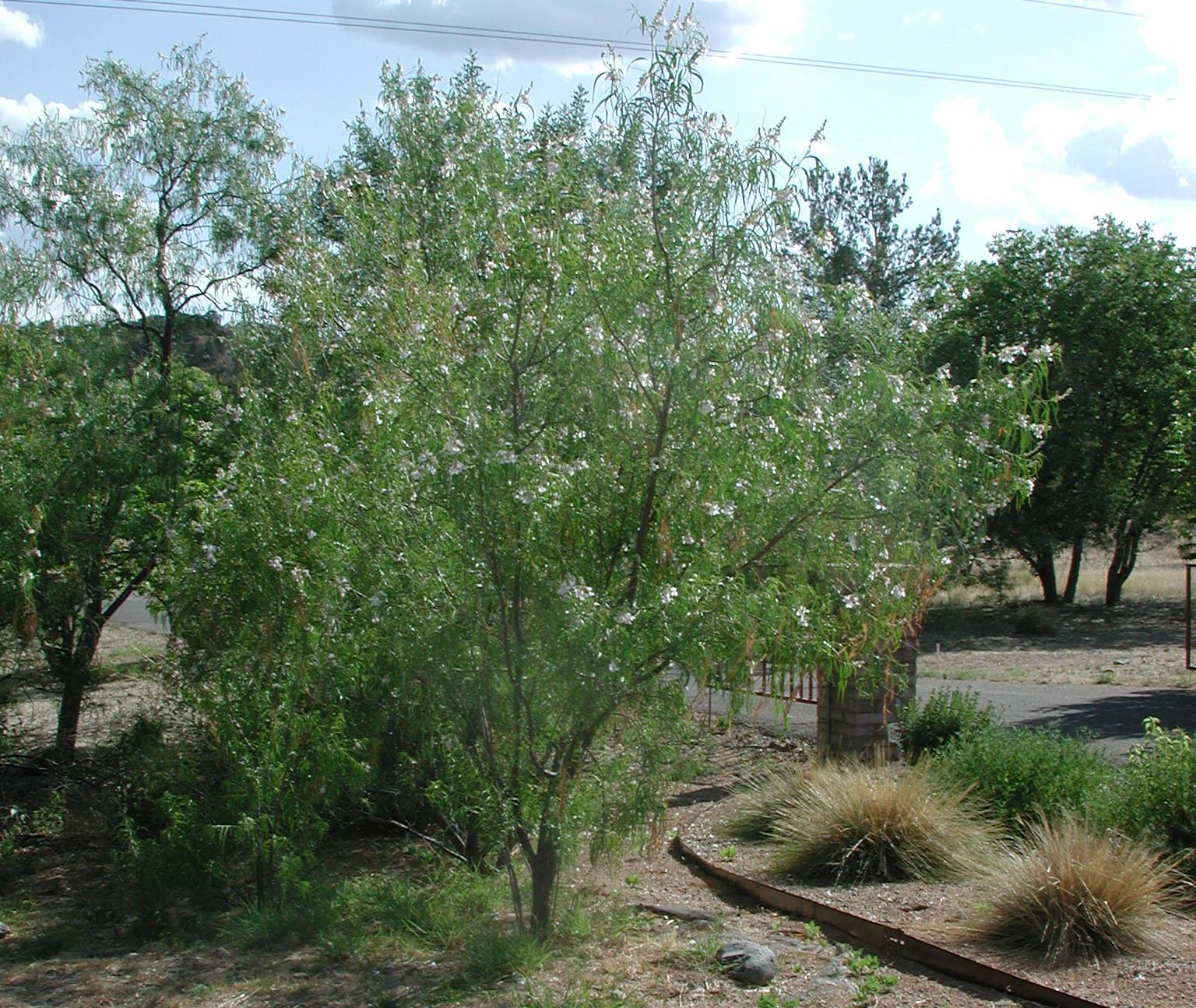desert willow tree varieties
1 2 m tall with a spread of up to 5 ft. Reaches 15 to 20 ft.
The Desert Willow A Beautiful Small Tree For Native Gardens The Real Dirt Blog Anr Blogs
10 20 feet.
. Chilopsis linearis Burgundy Burgundy Desert Willow. It boasts exceptional heat drought and cold tolerance and it roots and grows quickly. Desert-Willow should be grown in full sun and is extremely drought-tolerant although it responds to summer irrigation in the drier climates with nice growth a full canopy and flowers.
The multi-trunked well-branched growth habit and thick growth make the. Desert Willow is a deciduous tree dropping leaves early in the season but leaving seed pods on the tree that may remain throughout the winter. It can also be planted as a hedge.
Complimentary plantings alongside the Desert Willow include the Palo Verde or Texas Ranger. Bubba also develops fewer seed pods than other cultivars despite its long and extremely prolific blooming season. The shoots in the typical species are grey-brown.
Our Hybrid Desert Willows are quickly becoming a favorite accent tree for their fragrant burgundy trumpet-shaped blossoms that decorate this tree from spring to fall. Salix alba commonly referred to as the white willow is a medium-sized to large deciduous tree growing up to 1030 m tall with a trunk up to 1 m diameter and an irregular often-leaning crown. If growth is slow add rooting hormone to the water.
Typically dwarf willow varieties mature between 3 and 6 ft. The name derives from the white tone to the undersides of the leaves. One is the popular weeping willow Salix babylonica.
It is normally planted in order to control erosion along streams and lakes. Its native range extends from western. The size of mature trees is 15-30 feet tall and 10-20 feet wide.
Another common type of willow is the corkscrew willow Salix matsudana Tortusa. The Desert Willow known by its scientific name Chilopsis linearis is a native of the Desert Southwest growing at elevations up to 5000 feet. The purple osier willow is a shrub that has purple stems and blue-green leaves when the plants are juveniles.
Plant in the front yard to call attention to an entry. The leaves and the delicate branch structure mimic the appearance of a willow tree. The bark is grey-brown and deeply fissured in older trees.
This deciduous native treeshrub can be found along dry washes and seasonal creeks in desert chaparral and grassland habitats between 1500 and 5500 foot elevations. The colorful willow leaves are narrow pointed and lanceolate. Its main habitat ranges from the low desert to the grasslands.
Our Hybrid Desert Willow is a small to medium-sized flowering tree that blends well with any landscape style. Desert willow is not a willow at all but a close relative of the catalpa tree and a member of the trumpet vine family Bignoniaceae. It can handle some shade and dry soil.
This native plant ranges from Texas to California and northern Mexico. The bright-green leaves that cover the tree cast a light shade underneath the canopy. The species name refers to the narrow linear 6 inch leaves of the small tree that grows up to 25 feet on average.
Place your cutting in a jar of water and wait for roots to appear. Desert Willow Tree Facts. Desert Willow Chilopsis linearis which resembles willows is a small rapidly growing tree with exotic-looking blooms that are favored by hummingbirds.
Desert Willow is drought tolerant and easy to maintain. Peachleaf Willow Salix Amygdaloides Called peachleaf willow because the leaves are pointed just like those of peach trees this is a large tree from North America that feels at ease in large gardens or parks. Ranging from pale pink to pale violet they give way to beanlike pods 6-10 in.
Cut a small branch of softwood desert willow closest to a leaf node. Chilopsis linearis Desert Willow is a spreading deciduous shrub or small deciduous tree adorned with narrow willowy leaves and showy flower clusters from late spring to fall. Like larger weeping willows the dwarf cultivars have narrow pointed leaves and produce yellow furry flowers.
The long slender leaves make you think of willow but once you learn some desert willow tree facts youll see that it is not in the willow family at all. Native to the Southwestern United States the plant is not widely known but deserving of wider use. The Desert Willow also known as Chilopsis linearis is a highly tolerant unique plant that blossoms its shade from purple pink white or yellow.
Borne at the tips of the branches the sweetly fragrant trumpet-shaped flowers are reminiscent of catalpa blossoms. Follow the instructions on your specific brand. Chilopsis Desert Willow.
The attractive flowers and stems can be used in crafts. This native of the desert Southwest is found in dry washes of the low desert including the Mohave and Colorado deserts. A most drought and heat resistant flowering tree makes the ideal specimen plant for water challenged communities.
Desert Willow tolerates various types of soils but will certainly do best in one that is well-draining. They range from Nevada southern California through New Mexico and Arizona to northern Mexico and west Texas. It prefers full sun conditions and is extremely drought-tolerant.
It grows to 2 to 5 inches in height 5 to 12 cm. This trees name certainly gives you clues to its attributes. Flowers begin blooming in spring and continue through fall.
While the trees will grow and flower better with adequate moisture they will not tolerate over-watering. The pH can be alkaline neutral or acidic. 15 30 feet.
This is a tree that grows to 40 feet 12 m tall and wide. Once roots have developed and there are three to five roots transfer into. Trees are fast growing at first but once established will slow down.
It is closely related to Catalpa Tecoma and Campsis all members of the Bignoniacea family. Its linear leaves are wider and greener than those of other desert willow cultivars which gives this tree a much fuller appearance. And while the desert-willow is not actually related to the willow the tree does resemble it in appearance.
Its a small delicate tree that usually doesnt grow above 30 feet 9 m tall and 25 feet 75. The branches cascade down making it appear to be weeping. Dip your cutting in rooting hormone.
This tree grows to 40 feet 12 m high with a canopy spread of some 30 feet 9 m. These Southwest natives feature long and narrow willow-like leaves hence their name. Desert willow Chilopsis linearis is a fabulous small growing native tree loved for its showy tropical-looking flowers.
The desert willows scientific name is Chilopsis linearis.

Desert Willow Chilopsis Linearis Plant Of The Month

Gv Gardeners Desert Willow Trees In Bloom Get Out Gvnews Com

Desert Willow Tree Drought Tolerant Tree Guzmansgreenhouse Com

Civano Growers Introduces Desert Willow Bubba Series Nursery Management

Backyard Gardener The Desert Willow Tree June 25 2014

Desert Willow Tree Horticulture Unlimited Desert Willow Tree Desert Willow Willow Trees Garden
/desert-willow-growing-guide-5210875-hero-e52d765406ce487e8b5f01ab3e8ff362.jpg)
How To Grow And Care For Desert Willow

Desert Willow Tree Drought Tolerant Tree Guzmansgreenhouse Com

Desert Willow Trees Dallas Fannin Tree Farm Frisco Tx

Desert Willow Tree Horticulture Unlimited

Desert Willow Love This Flowering Tree And So Do Hummingbirds And Bees Drought Tolerant Will Re Drought Tolerant Landscape Desert Willow Desert Landscaping

Chilopsis Linearis Monhews Timeless Beauty Desert Willow High Country Gardens

April Art S Seedless Desert Willow Desert Willow Santa Fe Botanical Garden

Chilopsis Linearis Art S Seedless Seedless Desert Willow Mountain States Wholesale Nursery

Desert Willow Archives Desert Gardening 101
The Desert Willow A Beautiful Small Tree For Native Gardens The Real Dirt Blog Anr Blogs

Planting Desert Willow Chilopsis Linearis High Country Gardens

Desert Willow Chilopsis Linearis Plant Of The Month
The Desert Willow A Beautiful Small Tree For Native Gardens The Real Dirt Blog Anr Blogs